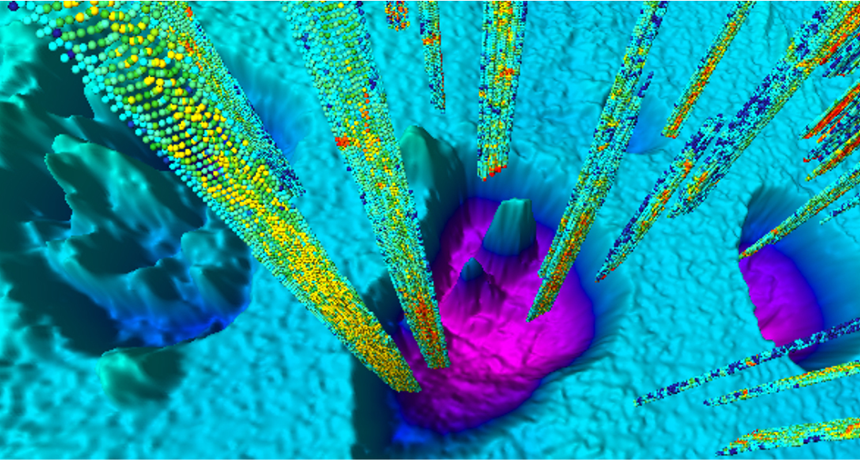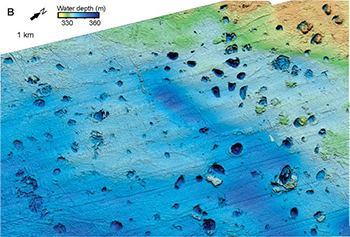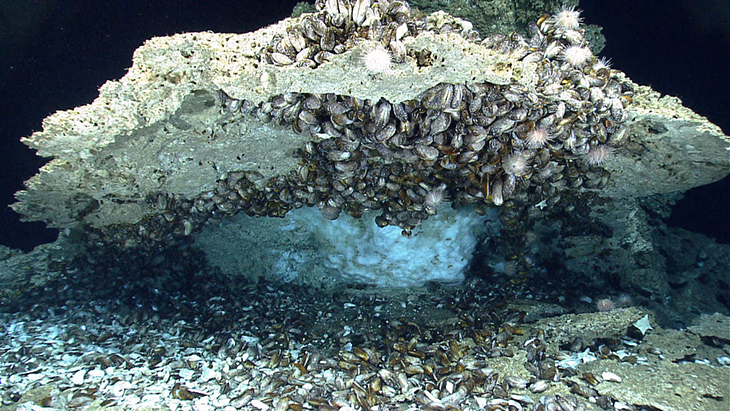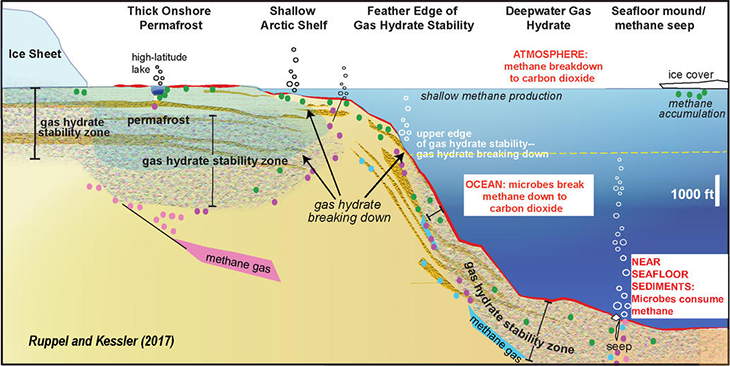Ancient Arctic ‘gas’ melt triggered enormous seafloor explosions
Telltale monster craters reveal a violent side to melting ice — one that could repeat soon

Ancient methane explosions left craters in the Arctic seafloor (a few of which are mapped here). Some of them still spew methane gas (yellow plumes) today. And newfound sites nearby appear poised to blow open new half-mile-wide craters in bedrock.
Andreia Plaza Faverola/CAGE
By Beth Geiger
Massive craters pockmark the bottom of the Barents Sea, north of Norway. They point to past explosions there, a new study finds. As domes of frozen methane destabilized within this seabed some 12,000 years ago, they blasted open the seafloor. Triggered by the waning of the last Ice Age, these events are truly ancient history. But they also point to the power of Arctic warming — underway once again — to reshape the polar oceans.

The craters are huge and extensive. What’s more, they formed violently, the new study concludes. Karin Andreassen is a marine geologist at the Arctic University of Norway in Tromsø. She notes that the craters were first discovered in the early 1990s. Until now, however, no one realized how big most were or how extensively they pitted the seafloor.
Andreassen’s team found more than 100 giant craters within an area covering 440 square kilometers (170 square miles) — half the size of Dallas, Texas. Some craters span a kilometer (0.6 mile) across. The team also discovered previously unknown, 20-meter (65-foot) tall domes near some of the craters.
Andreassen and her team described their findings June 2 in Science.
Story continues below video.
Mega-burps
Rich deposits of methane hydrate underlie much of the Arctic seafloor. This material is basically ice made from methane gas. It occurs in seabed layers at sites (such as the Barents Sea) that are rich in methane. Cold temperatures, combined with the weight of water and rock there, crush the gas into a frozen, super-concentrated form.
Some 16,000 years ago, the Barents Sea was covered by an ice sheet two kilometers (1.2 miles) thick. That provided all the pressure and cold needed to keep the methane hydrate stable, Andreassen explains. But then, this massive sheet of ice began to melt. The zone where methane hydrate remained stable now shrank. In time, the icy hydrate began collecting in bulging domes atop the seafloor.
Story continues below image.

When the ice thinned and temperatures warmed enough, the methane hydrate disintegrated. It literally exploded back into a gas like ginormous burps. That gas burst out of the domes, leaving giant craters. What makes this really impressive, Andreassen notes, is that “the craters are carved into bedrock, not just sediment. That means the force must have been quite enormous when they blew.”
The researchers also discovered plumes of methane that are still streaming out of these craters, 12,000 years later.
To collect their data, Andreassen and her team spent weeks on a research ship on the stormy Barents Sea. (This meant that much of the time they were fighting seasickness, she says.) The researchers used a range of tools to map the seafloor’s topography — changes in its highs and lows. For instance, they broadcast acoustic signals, creating pressure waves at the seafloor. By listening for the return signal — a technique known as echo sounding — they were able to see the craters and domes in high resolution, three-dimensional detail. They also used seismic waves to explore structures below the seabed. Finally, they tracked methane plumes by monitoring the sound waves caused by rising gas bubbles.
Later, back in Tromsø, the researchers ran computer models. These attempted to determine how ice thicknesses, temperatures and gas-hydrate stability likely changed over tens of thousands of years.
This multipronged approach makes the study especially useful, says geologist Carolyn Ruppel. She heads the gas hydrates program at a U.S. Geological Survey field center in Woods Hole, Mass., and was not involved in the new work. “The data is really complete,” says Ruppel. “They have the data below the seafloor, the seafloor data — and to top it off they have the water column with the gas plumes.”
The domes look strikingly similar to dry-land Arctic features called pingos. Indeed, she says, the new study provides an “elegant” explanation for how pingo-like structures might form underwater.
Story continues below video.
Domes of doom?
Today, Earth is experiencing a rapid global warming. And no place is warming faster than the Arctic. The new findings point to what might occur if Earth’s fever continues to rise.
Methane is a powerful greenhouse gas, for example. Normal methane plumes only bubble up about 200 meters into the water, notes Andreassen. Violent dome explosions, however, may be a different story. “I think when the craters formed, methane definitely had the potential to reach the surface,” she says.
Might future exploding methane domes, triggered by melting ice, release extra methane into the atmosphere? Or, will valuable reservoirs of this natural gas be blown away in a blast of bubbles? (Research centers for years have been looking at these hydrates as a fossil-fuel source that might be mined to provide energy.) Answers to these questions are unknown, says Andreassen.
Yet people may glean some answers soon. Days after this study was published, a second, related study came out. It was authored by a team of scientists who were led by Andreassen’s graduate student Pavel Serov. Its new report appeared June 5 in the Proceedings of the National Academy of Sciences.
Its discovery? More big domes on the bottom of the Barents Sea, not far from Andreassen’s ancient craters. But the newly reported domes aren’t old. They are fresh, and they are leaking methane like crazy. Any year now, the domes could blow, Serov’s group now predicts. All it will take is a bit more warming.








